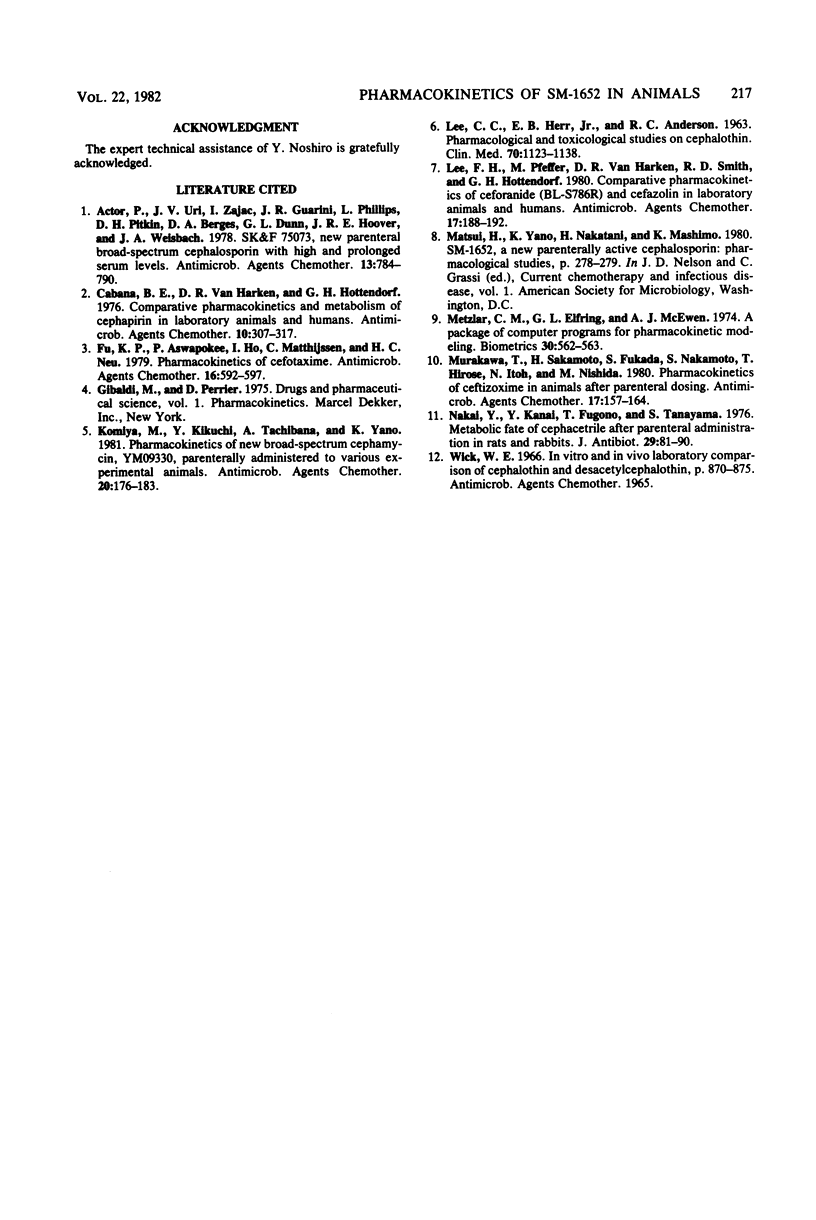Abstract
The pharmacokinetics of SM-1652 were studied in mice, rats, rabbits, dogs, and rhesus monkeys. The plasma half-lives of SM-1652, administered intravenously at a dose of 20 mg/kg, were 11.0 min in mice, 26.0 min in rats, 65.8 min in rabbits, 72.6 min in dogs, and 150.9 min in monkeys. The 24-h urinary excretion of SM-1652 was 30 to 35% of the dose in mice and rats, 70 to 75% in rabbits and dogs, and 45% in monkeys. Biliary excretion of the antibiotic over a 24-h period was 60 and 19% in rats and rabbits, respectively; it was 19% in dogs over a 9-h period after SM-1652 administration. Approximately 95% of the intravenous dose of SM-1652 was recovered as the unchanged form in the urine and bile of rats and rabbits. The binding of SM-1652 to serum protein was 44.0% in mice, 46.0% in rats, 90.4% in rabbits, 93.2% in monkeys, 30.0% in dogs, and 96.3% in humans.
Full text
PDF




Selected References
These references are in PubMed. This may not be the complete list of references from this article.
- Actor P., Uri J. V., Zajac I., Guarini J. R., Phillips L., Pitkin D. H., Berges D. A., Dunn G. L., Hoover J. R., Weisbach J. A. SK&F 75073, new parenteral broad-spectrum cephalosporin with high and prolonged serum levels. Antimicrob Agents Chemother. 1978 May;13(5):784–790. doi: 10.1128/aac.13.5.784. [DOI] [PMC free article] [PubMed] [Google Scholar]
- Cabana B. E., van Harken D. R., Hottendorf G. H. Comparative pharmacokinetics and metabolism of cephapirin in laboratory animals and humans. Antimicrob Agents Chemother. 1976 Aug;10(2):307–317. doi: 10.1128/aac.10.2.307. [DOI] [PMC free article] [PubMed] [Google Scholar]
- Fu K. P., Aswapokee P., Ho I., Matthijssen C., Neu H. C. Pharmacokinetics of cefotaxime. Antimicrob Agents Chemother. 1979 Nov;16(5):592–597. doi: 10.1128/aac.16.5.592. [DOI] [PMC free article] [PubMed] [Google Scholar]
- Komiya M., Kikuchi Y., Tachibana A., Yano K. Pharmacokinetics of new broad-spectrum cephamycin, YM09330, parenterally administered to various experimental animals. Antimicrob Agents Chemother. 1981 Aug;20(2):176–183. doi: 10.1128/aac.20.2.176. [DOI] [PMC free article] [PubMed] [Google Scholar]
- LEE C. C., HERR E. B., Jr, ANDERSON R. C. Pharmacological and toxicological studies on cephalotin. Clin Med (Northfield) 1963 Jun;70:1123–1138. [PubMed] [Google Scholar]
- Lee F. H., Pfeffer M., Van Harken D. R., Smyth R. D., Hottendorf G. H. Comparative pharmacokinetics of ceforanide (BL-S786R) and cefazolin in laboratory animals and humans. Antimicrob Agents Chemother. 1980 Feb;17(2):188–192. doi: 10.1128/aac.17.2.188. [DOI] [PMC free article] [PubMed] [Google Scholar]
- Murakawa T., Sakamoto H., Fukada S., Nakamoto S., Hirose T., Itoh N., Nishida M. Pharmacokinetics of ceftizoxime in animals after parenteral dosing. Antimicrob Agents Chemother. 1980 Feb;17(2):157–164. doi: 10.1128/aac.17.2.157. [DOI] [PMC free article] [PubMed] [Google Scholar]
- Nakai Y., Kanai Y., Fugono T., Tanayama S. Metabolic fate of cephacetrile after parenteral administration in rats and rabbits. J Antibiot (Tokyo) 1976 Jan;29(1):81–90. doi: 10.7164/antibiotics.29.81. [DOI] [PubMed] [Google Scholar]


